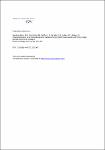Characterization of a monoclonal anti-capsid antibody that cross-reacts with three major primate lentivirus lineages
Sanders-Beer, Brigitte E.
Eschricht, Magdalena
Seifried, Janna
Hirsch, Vanessa M.
Allan, Jonathan S.
Norley, Stephen
Mouse monoclonal antibodies with varying specificities against the Gag capsid of simian and human immunodeficiency virus (SIV/HIV) were generated by immunizing mice with whole inactivated SIVagmTYO-1. Monoclonal antibody AG3.0 showed the broadest reactivity recognizing the Gag capsid protein (p24-27) and Gag precursors p38, p55, and p150 of HIV-1, HIV-2, SIVmac, and SIVagm. Using overlapping peptides, the AG3.0 epitope was mapped in capsid to a sequence (SPRTLNA) conserved among HIV-1, HIV-2, SIVrcm, SIVsm/mac, and SIVagm related viruses. Because of its broad cross-reactivity, AG3.0 was used to develop an antigen capture assay with a lower detection limit of 100 pg/ml HIV-1 Gag p24. Interestingly, AG3.0 was found to have a faster binding on/off rate for SIVagmVer and SIVmac Gag than for SIVagmSab Gag, possibly due to differences outside the SPRTLNA motif. In addition, the ribonucleic acid (RNA) coding for AG3.0 was sequenced to facilitate the development of humanized monoclonal antibodies.
Dateien zu dieser Publikation
Keine Lizenzangabe

